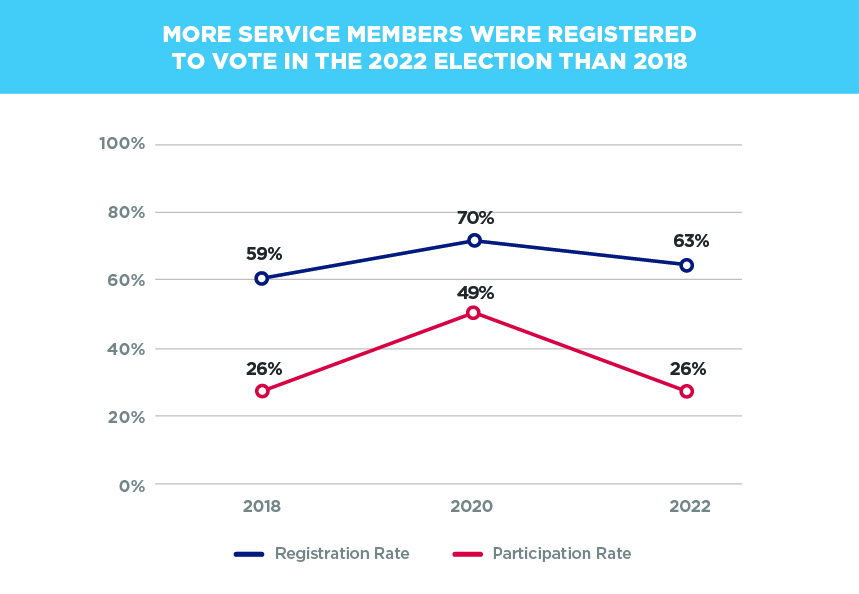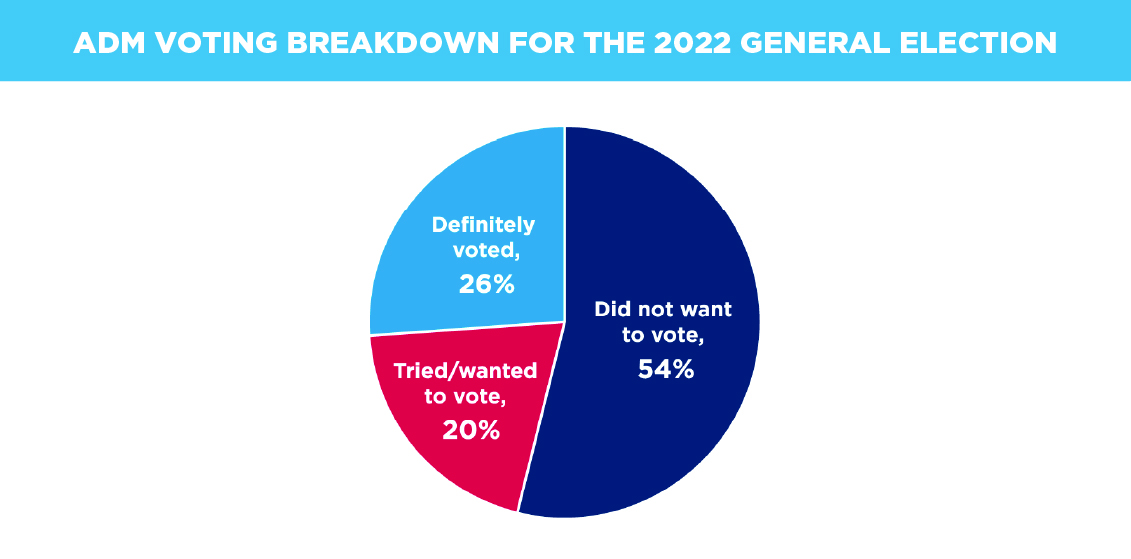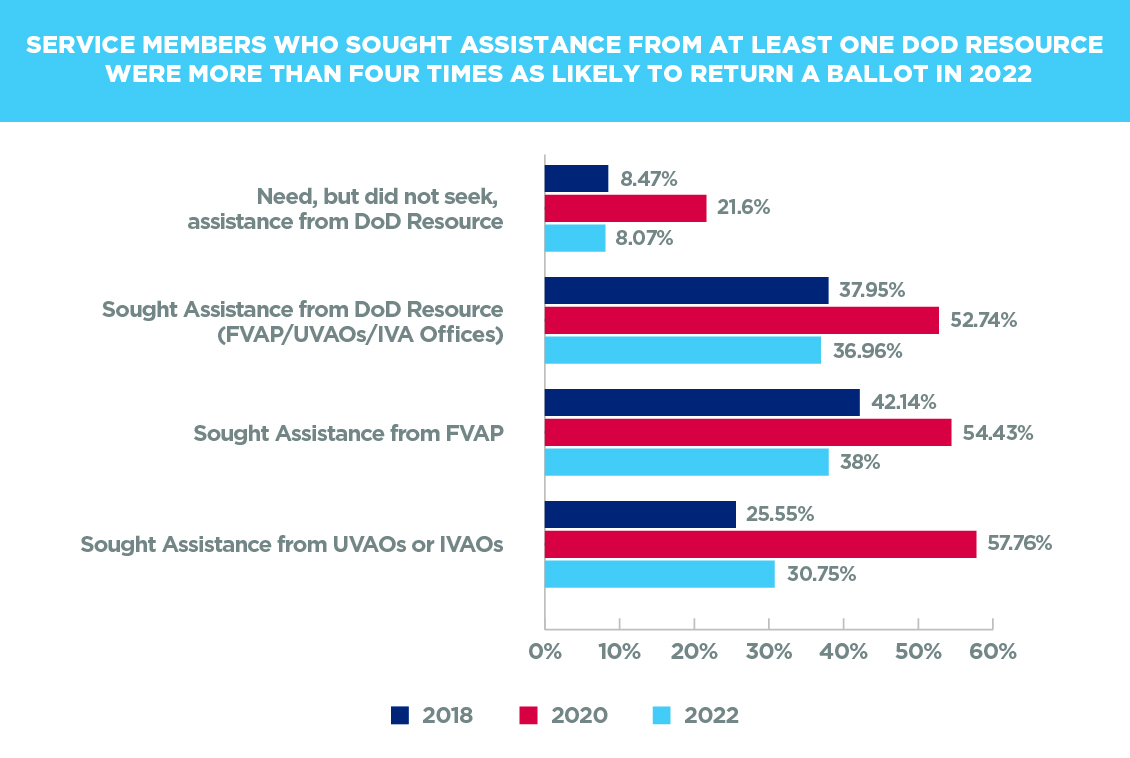State of the Military Voter
About three-quarters of the 1.3 million active duty military members are eligible to vote absentee with special protections because they're stationed away from their voting residence.
Voting is more complicated for military members stationed away from home than for local voters. Some states require them to update their registration and request an absentee ballot every year. State's rules on how election paperwork can be sent and received may require the use of printers and scanners, or involve long mailing times. Most need to vote earlier than local voters so that their ballots are received by voting deadlines.
To learn more about military voters and help them navigate their state's absentee voting process, FVAP conducts the Post-Election Voting Survey – Active Duty Military (PEVS-ADM) every two years following the general election. The most recent report details military voting behaviors in 2022.
The Military Voter in 2022
Since 1986, military members on active duty stationed away from their voting residence have been covered by the Uniformed and Overseas Citizens Absentee Voting Act (UOCAVA), which requires that states allow these military members, their eligible family, and overseas citizens to vote absentee in federal elections. The Military and Overseas Voter Empowerment (MOVE) Act amended UOCAVA in 2009 to require that states:
- Transmit ballots at least 45 days before federal elections
- Offer at least one method of electronic transmission (email, fax, online portal, etc.) of voting information and blank ballots
- Transmit ballots automatically within the calendar year of a standing ballot request
Over the course of 3 presidential elections and 4 midterm elections since the UOCAVA amendments, voting data from the 2022 Midterm Election continues to show its impact on military voting. The amendments have given military members more time to vote by reducing time-related obstacles.
In 2022, 15% of military voters reported that either they didn't receive the ballot in time, or that the ballot never arrived, compared to 30% prior to the 2009 amendments. While UOCAVA has improved the military voting experience, there are still opportunities to support military members' ability to successfully vote absentee.
Here are some highlights of military voting in 2022.




63% of active military members were registered to vote in 2022 compared to 59% in 2018 — an increase of 4%. About three-quarters of active military members are eligible to vote absentee under UOCAVA because they live 50+ miles from their voting residence.




When adjusting for demographic differences between Service members and civilians (age, sex, education, etc.), the military voter registration rate increased by 3 percentage points from 2018 to 2022, while the registration rate for eligible civilian voters in the United States only increased by 2% in the 2022 election.




Although the military voter participation rate was substantially lower than for civilians in 2018 (26% vs. 52%, respectively), participation for Service members stayed the same in 2022, while civilian participation dropped 4 points to 48% from 52% in 2018.




Fewer active duty military members reported an interest in voting in 2022 compared to the 2018 election (51% to 37%). Overall participation in 2022 also decreased from 2018 (24% to 23%). The higher interest in voting in 2018 compared to 2022, with roughly the same participation rate, could indicate that there were a lot of Service members who followed the 2018 election but did not vote. This could indicate that the lower turnout among Service members may not be linked to obstacles facing military voters.




Further analysis of voting interest for active duty military found that in 2022, 72% of military members who did not vote said it was because of lack of motivation, such as choosing the "I did not want to vote" survey response option. This is a slight increase from 2018.




Among those who tried or wanted to vote, more than 80% reported being aware of their right to vote absentee when stationed away from their voting residence. Among Service members aged 18-24, the level of awareness of the right to vote was lower than for those that are over 24 years. Overall, more than 90% of active duty military were familiar with their voting rights, while those in the 18-24 age bracket had an 86% familiarity with this right.




Overall knowledge of absentee voting processes was lower by 1 to 3 percentage points in each category in 2022 compared to 2018.
Many states allow the use of electronic options for sending and receiving election materials between voters and election officials; however, mail is the only universally accepted method for returning ballots with many states requiring voted absentee ballots be returned by mail. 33 states and territories currently allow military absentee voters to submit their voted ballots using one or more electronic methods. The states with the largest number of UOCAVA voters provide an array of voted ballot return options – California (fax or mail), Florida (fax or mail), New York (mail only), Texas (Mail only except fax for hazardous duty pay areas), and Washington (email. fax, or mail).
In total, 13% of active military members indicated that they requested a ballot in 2022. Additionally, 9% said they did not request, but automatically received, a ballot, and 13.8% indicated they had expected to get a ballot but did not receive it.
Of the 13% of active military members that requested a ballot, 80% indicated that they received one. Among those who received an absentee ballot, either because they requested one or because one was automatically sent to them by their election office, 59.7% indicated that they returned their ballot.




There are numerous reasons motivated military non-voters did not cast a ballot. Some lacked procedural information about how to complete the absentee voting process. Others experienced challenges with the process itself that they were unable to overcome. Difficulty requesting a ballot, absentee ballots that did not arrive, and general confusion about the process were among the most frequently mentioned difficulties among would-be voters.








Active military members seeking assistance from a DoD resource is significantly related to higher ballot return rates. 37% of military members who sought assistance from at least one DoD resource returned a ballot in 2022. This consistent finding across the last five general elections (2012, 2014, 2016, 2018, and 2020) speaks to the importance and effectiveness of efforts by FVAP and the Military Departments and Services to raise awareness of available resources and provide direct assistance.
Documenting the State of the Military Voter after Every Election
FVAP conducts post-election surveys and studies voter file data after every federal election. The State of the Military Voter highlights recent statistics on military voting based on the Post-Election Voting Survey of Active Duty Military (PEVS-ADM) which is sent out to a sample of active duty members after each general federal election. See the 2022 PEVS-ADM Technical Report, and previous PEVS-ADM reports here:
More information on military voting is available in FVAP's Interactive Data Center and Post-Election Report to Congress. See FVAP's repository of military voting data and reports extending back to 1962.
Separately, FVAP releases research on the voting experiences of U.S. citizens residing abroad as part of the State of the Overseas Voter.




